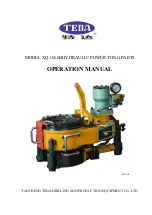
Model XQ114/6B HYDRAULIC SUCKER ROD TONG OPERATION MANUAL
YANCHENG TEDA DRILLING & PRODUCTION EQUIPMENT CO.,LTD
1
1.
Summary
Model XQ114/6B(4 1/2") hydraulic power tong is an open type power tong for the making up and breaking out of
tubing in well services. This product has the following features:
1.1 The tong is made up of master tong and backup tong, the master tong has a high and low gear train, the tong
is compact, light and efficient.
1.2 The master tong and backup hydraulics operate on valve banks independent of each other.
1.3 There is an evident speed :high speed at top grade and large torque at low grade.
1.4 The tong has incorporated a new system of disc brake to hold the jaws to connection more effectively.
1.5 Makeup and breakout are made easy with a simple turn to the reset knob on the tong and backup.
1.6 The backup has been supplied with quick coupling hoses and connections for quick and easy installation for
jobs where you need a backup and the backup can be removed in seconds for jobs that a backup is not
required.
2. SEPCIFICATION
2.1 Application tubing range:
73mm -114mm
(2 7/8"-4 1/2")
2.2 High gear rated torque:
1.5 kN·m (1100 ft·lbs)
2.3 Low gear rated torque:
6 kN·m
(4400 ft·lbs)
2.4 High gear max rotation speed:
85rpm
2.5 Low gear max rotation speed:
20 rpm
2.6 Opening of tong head:
118mm
(4.6")
2.7 Overall dimension (L×W×H):
750×500×600mm (29.5"×19.7"×23.6")
2.8 Weight:
220kg
( 485 lbs)
2.9 Rated system pressure:
11MPa
(1600 PSI)
2.10 Max oil supply:
100L/min
(26GPM)
3. INSTALLATION
3.1 Examination before installation
●Examine the power tong, if damage by transportation should be maintain.
●Examine the fastener, if loose tightened.
3.2 Hanging
Connect lift with tong hanging rod(Z6-42) and hang the tong on the derrick of
workover rig. The hanging height is proper when the backup tong could rightly
grip the tubing collar(see Fig.1).
●The hanging point is 15 m above ground.
●Under free hanging, power tong head’s center is about 0.5m above the well
center.
●Adjust the extend end of suspender face down, when installing the casket.
Fig.1



















